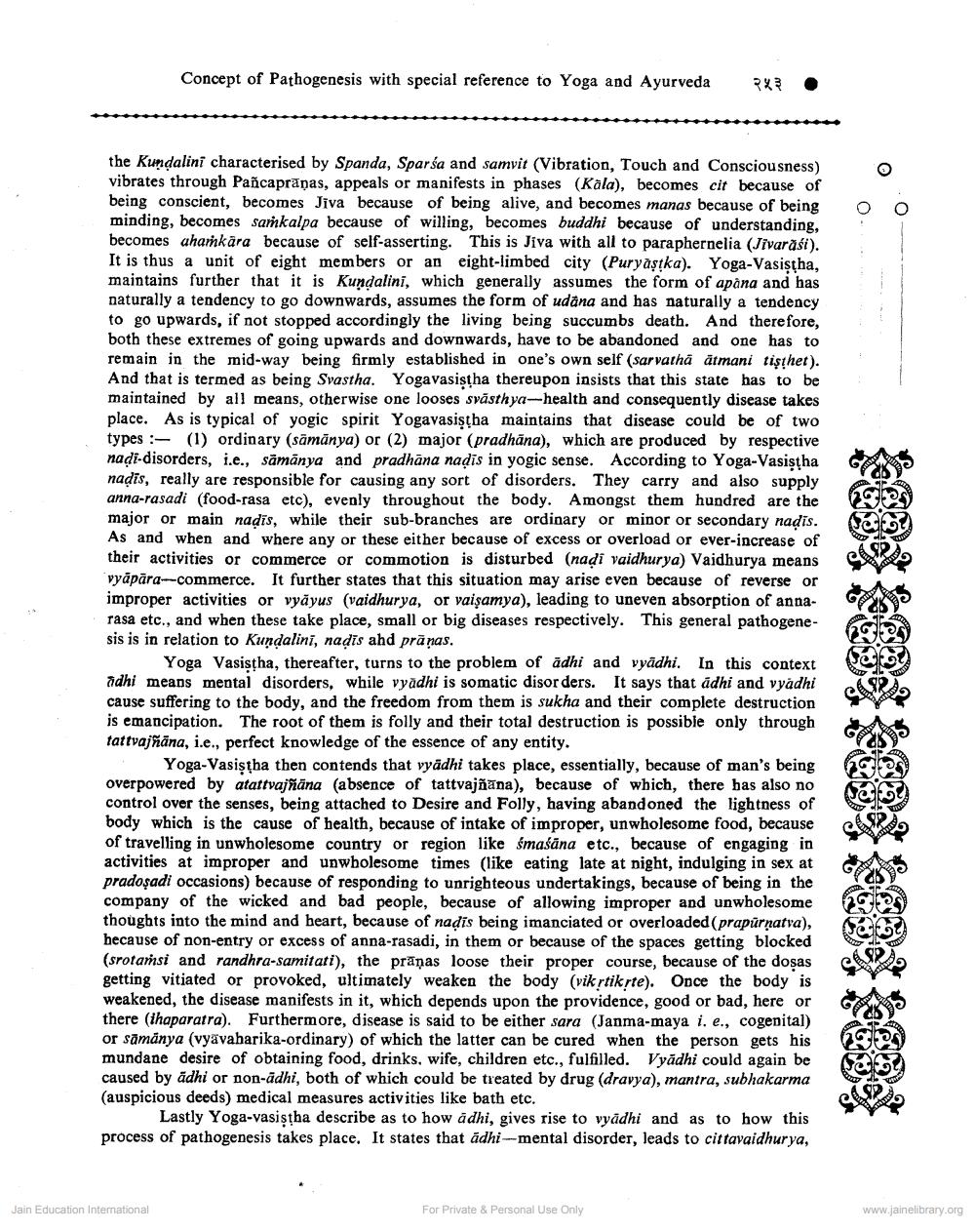________________
Concept of Pathogenesis with special reference to Yoga and Ayurveda
२५३
the Kundalini characterised by Spanda, Sparsa and samvit (Vibration, Touch and Consciousness) vibrates through Pañcaprānas, appeals or manifests in phases (Kala), becomes cit because of being conscient, becomes Jiva because of being alive, and becomes manas because of being minding, becomes sarnkalpa because of willing, becomes buddhi because of understanding, becomes ahankāra because of self-asserting. This is Jiva with all to paraphernelia (Jivarāśi). It is thus a unit of eight members or an eight-limbed city (Puryastka). Yoga-Vasistha, maintains further that it is Kundalini, which generally assumes the form of apana and has naturally a tendency to go downwards, assumes the form of udana and has naturally a tendency to go upwards, if not stopped accordingly the living being succumbs death. And therefore, both these extremes of going upwards and downwards, have to be abandoned and one has to remain in the mid-way being firmly established in one's own self (sarvathā ātmani tişthet). And that is termed as being Svastha. Yogavasistha thereupon insists that this state has to be maintained by all means, otherwise one looses svāsthya--health and consequently disease takes place. As is typical of yogic spirit Yogavasisha maintains that disease could be of two types: (1) ordinary (sāmänya) or (2) major (pradhāna), which are produced by respective nadi-disorders, i.e., sämānya and pradhāna nadis in yogic sense. According to Yoga-Vasiştha nadis, really are responsible for causing any sort of disorders. They carry and also supply anna-rasadi (food-rasa etc), evenly throughout the body. Amongst them hundred are the major or main nadis, while their sub-branches are ordinary or minor or secondary nadis. As and when and where any or these either because of excess or overload or ever-increase of their activities or commerce or commotion is disturbed (nadi vaidhurya) Vaidhurya means vyāpāra-commerce. It further states that this situation may arise even because of reverse or improper activities or vyāyus (vaidhurya, or vaişamya), leading to uneven absorption of annarasa etc., and when these take place, small or big diseases respectively. This general pathogenesis is in relation to Kundalini, nadis and prānas.
Yoga Vasistha, thereafter, turns to the problem of ādhi and vyâdhi. In this context adhi means mental disorders, while vyadhi is somatic disorders. It says that adhi and vyadhi cause suffering to the body, and the freedom from them is sukha and their complete destruction is emancipation. The root of them is folly and their total destruction is possible only through tattvajñāna, i.e., perfect knowledge of the essence of any entity.
Yoga-Vasiştha then contends that vyādhi takes place, essentially, because of man's being overpowered by atattvajñāna (absence of tattvajñāna), because of which, there has also no control over the senses, being attached to Desire and Folly, having abandoned the lightness of body which is the cause of health, because of intake of improper, unwholesome food, because of travelling in unwholesome country or region like smaśāna etc., because of engaging in activities at improper and unwholesome times (like eating late at night, indulging in sex at pradoşadi occasions) because of responding to unrighteous undertakings, because of being in the company of the wicked and bad people, because of allowing improper and unwholesome thoughts into the mind and heart, because of nadis being imanciated or overloaded (prapūrnatra), hecause of non-entry or excess of anna-rasadi, in them or because of the spaces getting blocked (srotamsi and randhra-samitati), the prānas loose their proper course, because of the dosas getting vitiated or provoked, ultimately weaken the body (vik rtik rte). Once the body is weakened, the disease manifests in it, which depends upon the providence, good or bad, here or there (ihaparatra). Furthermore, disease is said to be either sara (Janma-maya i. e., cogenital) or sāmánya (vyavaharika-ordinary) of which the latter can be cured when the person gets his mundane desire of obtaining food, drinks, wife, children etc., fulfilled. Vyādhi could again be caused by adhi or non-adhi, both of which could be treated by drug (dravya), mantra, subhakarma (auspicious deeds) medical measures activities like bath etc.
Lastly Yoga-vasistha describe as to how adhi, gives rise to vyādhi and as to how this process of pathogenesis takes place. It states that adhi--mental disorder, leads to cittavaidhurya,
o
Jain Education International
For Private & Personal Use Only
www.jainelibrary.org




